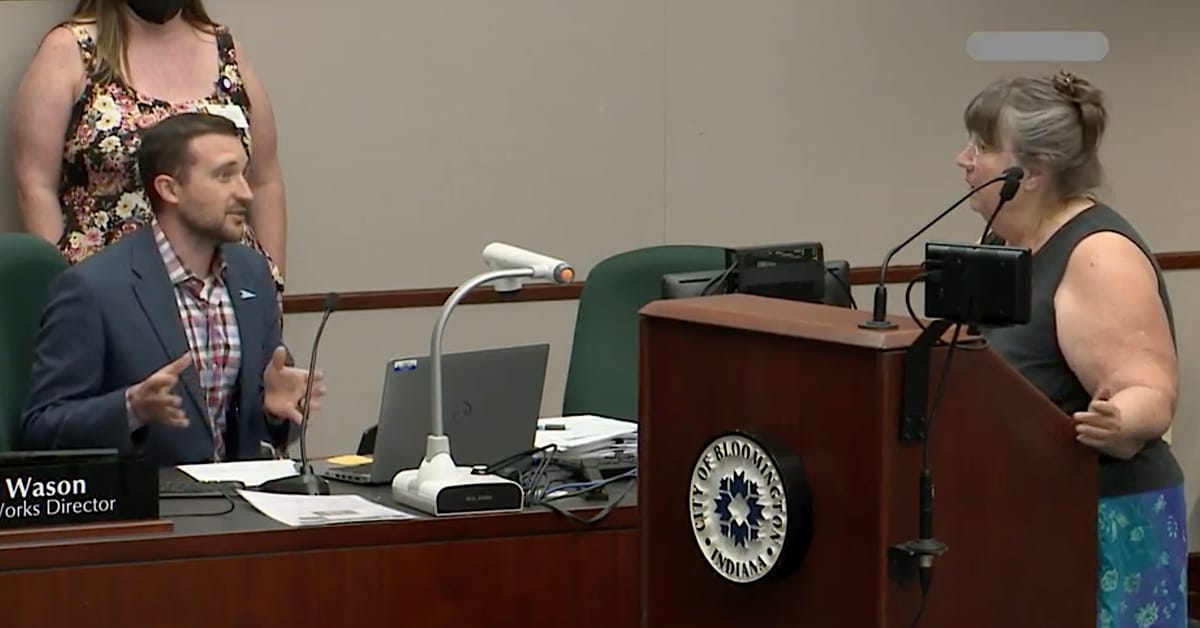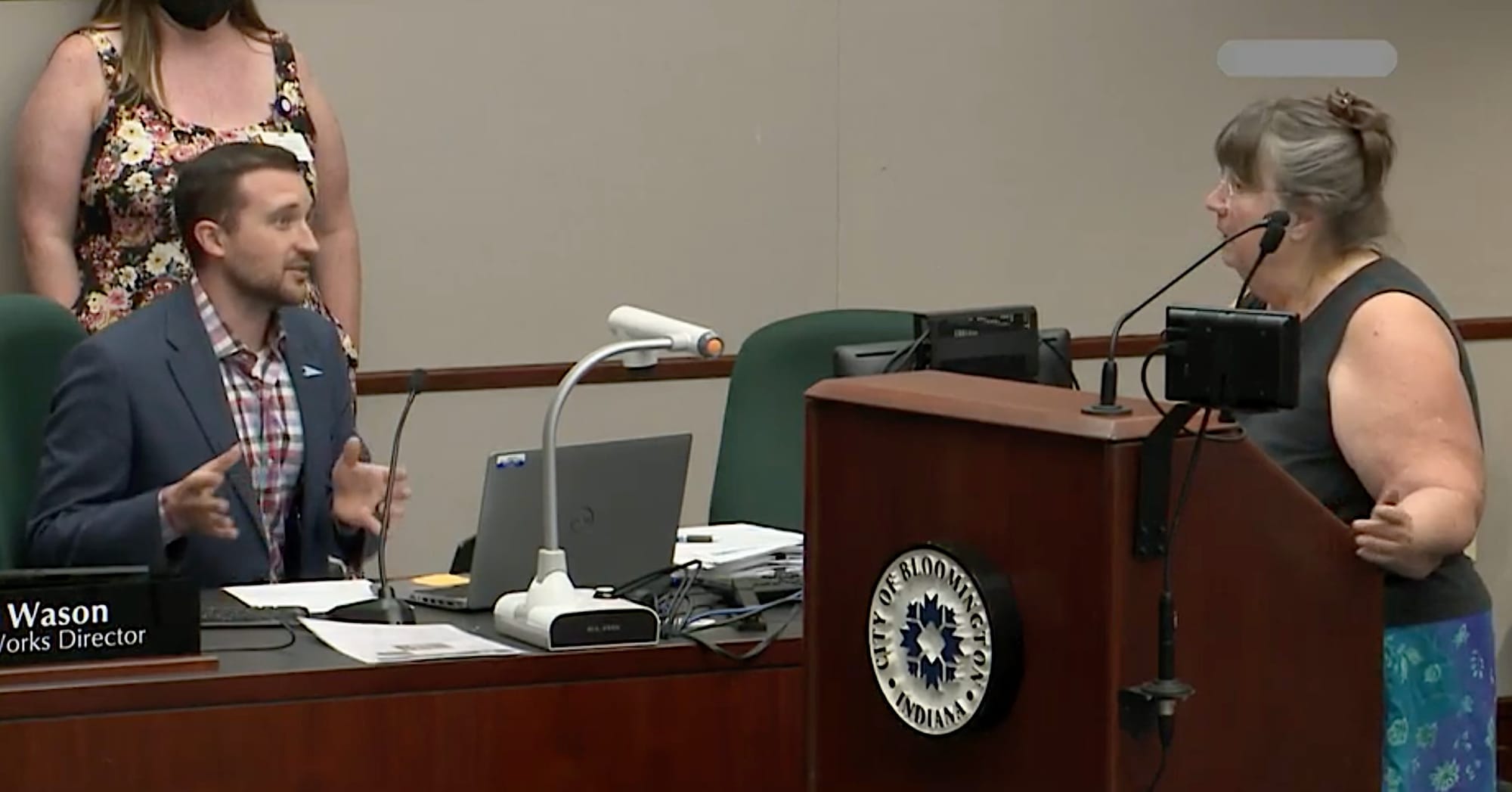Bloomington says bamboo ban means longtime resident must purge invasive species from yard



“Because bamboo is nasty, and you can’t get rid of it.”
That’s a two-and-a-half-year-old quote from Bloomington city councilmember Isabel Piedmont-Smith. Her remark came around 8 p.m. on Dec. 3, 2019 when the city council was considering a series of amendments to the city’s unified development ordinance (UDO).
Piedmont-Smith was explaining why she was, at the city staff’s request, introducing an amendment to add yellow groove bamboo (Phyllostachys aureosulcata) to the city’s list of prohibited invasive grasses.
Yellow groove bamboo is one of the plants included in the Indiana Department of Natural Resources plan for managing invasive species. It can be hard to contain, because it shoots out horizontal underground plant stems that reproduce the root systems of a new plant.
The council’s 2019 approval of the amendment banning yellow groove bamboo means that city resident Karen Cherrington is now required to eradicate the bamboo plants that are growing on her West 6th Street property.
It’s not just the fact that the plants are on the banned list—they are also too tall, exceeding the city’s eight-inch limit for “weeds, grass, or noxious plants.”
About a year ago the city’s housing and neighborhood development (HAND) department started issuing citations and fines for Cherrington’s bamboo.
Cherrington’s appeal of her citations and escalating fines was heard on Tuesday by Bloomington’s three-member board of public works (BPW).
In her written appeal, Cherrington described herself like this: “I am physically unable to mow or cut myself. I will be 74 my next birthday, had a hip replacement, and have four compression fractures in my back, so any work like this I need to hire out.”
Cherrington also described how she has maintained the bamboo for 30 years to keep it from spreading. She asked the BPW to consider bamboo as allowable on her property, as a kind of legacy—on the principle that it predates the city council’s ordinance change. She described the cost of digging up all the bamboo as thousands of dollars, which she does not have to spare, she said.
Tuesday’s verdict from the BPW: Cherrington’s fines are being waived for now, and she has 90 days from now to put together a plan for the removal of the bamboo and show progress towards removal.
That was consistent with the approach that assistant city attorney Daniel Dixon told the BPW that the city now wanted to take. Enforcement of the ban on yellow groove bamboo is going to be a bit more lenient than for other cases.
Because the plant has to be excavated to get rid of it, Dixon said that the city would be giving residents with yellow groove bamboo growing on their property 90 days to develop a plan. Compliance would be measured by checking for at least some reduction in the bamboo’s footprint. Dixon said complete eradication could take years.
Another reason given by Dixon for the more leniency: The city council’s decision to add yellow groove bamboo to the invasive species list was not commonly known.
Cherrington appeared at Tuesday’s BPW to argue her case. In the back-and-forth between her and public works director Adam Wason, she wondered if she was being targeted by the city for enforcement. Wason told her that the city had received complaints about her property—to the effect that the bamboo had been spreading. When Cherrington disputed that the plants had been spreading, Wason told her that was the nature of the complaints that the city had received.
Since 2020, a half dozen uReport cases—that’s Bloomington’s online reporting system for residents—have been filed about bamboo at different properties. Citations were issued in at least five cases, based on The B Square’s review. The uReport system is just one way that complaints can be made.
Cherrington said she had not planted the bamboo—it had just been there for 30 years. Wason told her that because the city council had passed the ordinance, the BPW did not have the option of allowing the bamboo to persist.
Google Street View imagery for the property does not go back 30 years. But the vintage 2014 Google Street View shows bamboo thriving there at least eight years ago.
Cherrington wants to keep the bamboo, in part because of the privacy it gives. She put it like this: “I just really like the bamboo. The birds love it. It gives off more oxygen than oak trees—it really does.”
According to an article published in Inside Climate News, at least for shorter-term carbon sequestration, bamboo does outpace trees.
Cherrington’s plea was unpersuasive to BPW members.
In parting, Cherrington was given a contact name in the city’s HAND department, as well as a potential resource to help with bamboo eradication—the nonprofit MC-IRIS (Monroe County–Identify and Reduce Invasive Species).




Comments ()